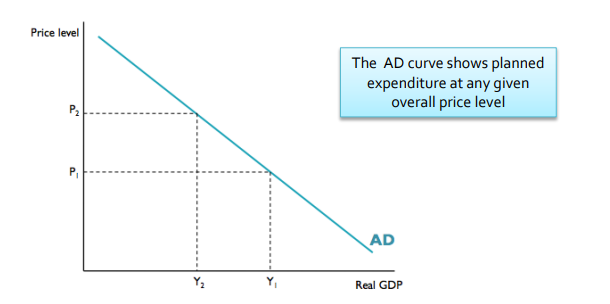Defining Aggregate Demand
- Aggregate demand is the total demand for goods and services produced in an economy at a given average price level in a certain time period.
- It is the equivalent to the expenditure method of measuring GDP, and using the income and output method will provide the same value.
Calculating Aggregate Demand
- AD = C + I + G + (X-M)
- C = Consumer spending
- I = Investments by firms
- G = Government spending
- X = Exports
- M = Imports
Diagram for Aggregate Demand
- The diagram for aggregate demand looks like a demand graph except the x-axis is replaced by Real GDP and any point on it represents national income, Y.
- The x-axis can also be called national expenditure, real national output, real national income, real income or real output.
- Y is used instead of Q when indicating aggregate demand or supply.

Similarities Between Aggregate Demand and Demand
- Both curves are downward sloping
- Both have non-price determinants that shift the curve
- Price or price level changes simply move along the curve rather than shift the curve.
Non-Price Determinants of Aggregate Demand
- As aggregate demand is given by the equation AD = C + I + G + (X-M), its determinants must be the components of the sum.
- Therefore the determinants of aggregate demand are consumer spending, investment, government spending and net exports.
Consumer Spending (C)
- Consumer spending is the spending done by households as they purchase goods and services from firms.
Determinants
- Taxes (Income taxes and VAT)
- Wealth (house prices, change in value stocks and shares)
- Interest Rates
- Consumer Confidence/Expectations of future
- Debts of Households
- The acronym TWICED can be used to remember the determinants of consumer spending.
Investment (I)
- Investment is defined as the investments and purchases by businesses.
Determinants
- Interest rates
- Business confidence
- Technology
- Business taxes
- Corporate Indebtedness
Government Spending (G)
- Political priorities and economic priorities are the two determinants of government spending.
- Voting influences how and where the government spends their budget.
- Macroeconomic policies applied by the government can also shift aggregate demand.
Determinants
- Political priorities
- Economic priorities
Net Exports (X-M)
- Exports have a positive affect on AD while imports have a negative affect on AD.
Determinants
- Income of trading partners
- Change in trade policies
- Health and safety requirements
Exchange rates
- Higher currency value leads to more imports and less exports
- Lower currency value leads to less imports but more exports